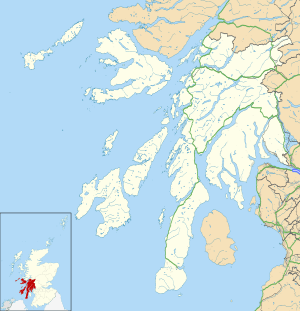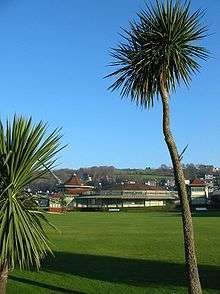Rothesay, Bute
| Rothesay | |
| Scottish Gaelic: Baile Bhòid [1] | |
 |
|
 Rothesay |
|
| Population | 4,850 [2] |
|---|---|
| – London | 469 miles |
| Council area | Argyll and Bute |
| Lieutenancy area | Argyll and Bute |
| Country | Scotland |
| Sovereign state | United Kingdom |
| Post town | ISLE OF BUTE |
| Postcode district | PA20 |
| Dialling code | 01700 |
| Police | Scottish |
| Fire | Scottish |
| Ambulance | Scottish |
| EU Parliament | Scotland |
| UK Parliament | Argyll and Bute |
| Scottish Parliament | Argyll and Bute |
Coordinates: 55°50′N 5°04′W / 55.83°N 5.07°W
The town of Rothesay ![]() i/ˈrɒθ.si/ (Scottish Gaelic: Baile Bhòid) is the principal town on the Isle of Bute, in the council area of Argyll and Bute, Scotland. It can be reached by ferry from Wemyss Bay which offers an onward rail link to Glasgow. At the centre of the town is Rothesay Castle, a ruined castle which dates back to the 13th century, and which is unique in Scotland for its circular plan. Rothesay lies along the coast of the Firth of Clyde.
i/ˈrɒθ.si/ (Scottish Gaelic: Baile Bhòid) is the principal town on the Isle of Bute, in the council area of Argyll and Bute, Scotland. It can be reached by ferry from Wemyss Bay which offers an onward rail link to Glasgow. At the centre of the town is Rothesay Castle, a ruined castle which dates back to the 13th century, and which is unique in Scotland for its circular plan. Rothesay lies along the coast of the Firth of Clyde.
History

The old town centred around Rothesay Castle, which dates from the 13th century. Long-ruinous it is nevertheless picturesque, and formed a focal point for tourists from the beginning of its evolution into a seaside resort.[3]
Rothesay was the county town in the civil parish of Rothesay in county of Bute, which included the islands of Great Cumbrae, Little Cumbrae and Arran. The county buildings, now partially closed down, overlook the castle.
During the Victorian era, Rothesay developed as a popular tourist destination. It became hugely popular with Glaswegians going "doon the watter" (lit: down the water, where the 'water' in question is the Firth of Clyde), and its wooden pier was once much busier with steamer traffic than it is today. Rothesay was also the location of one of Scotland's many hydropathic establishments during the 19th century boom years of the Hydropathy movement.[4][5] The town also had an electric tramway - the Rothesay and Ettrick Bay Light Railway - which stretched across the island to one of its largest beaches. However, this closed in the mid-1930s. The centre of activities was the Winter Gardens building (built 1923) which played host to some of the best known music hall entertainers of the day.
During World War II Rothesay Bay was the home port of HMS Cyclops, the depot ship for the 7th Submarine Flotilla. HMS Cyclops and the 7th Submarine Flotilla served as the training facility for virtually all British submariners who saw service during the war.[6] The Officer Concentration Station Rothsay was located here in 1941-1942.
The war memorial (1922) is by Pilkington Jackson.
The bauhaus-inspired Rothesay Pavilion of 1938, is designed by the Ayr architect, James Carrick. It is a major landmark on the seafront.
From the 1960s onwards, with the advent of cheap foreign package holidays, Rothesay's heyday was largely over. The Winter Gardens closed and lay derelict for many years. However, in the 1990s, it was redeveloped and is now a tourist information and exhibition centre.
Duke of Rothesay

The heir to the British throne is known as the Duke of Rothesay in Scotland. This practice was begun by Robert III, who regularly resided at Rothesay Castle, and first granted the title to his son David in 1398. The title was given to the heir of the Scottish throne until the Union of the Crowns in 1603. Unlike the equivalent English title of Duke of Cornwall, there is no land attached in the form of a Duchy. The main landowner on the island is the Marquess of Bute, whose principal seat, Mount Stuart, is located a few miles to the south.
Rothesay Post 2000


Rothesay is no longer the seaside town it used to be, with more tourists going to warmer countries such as Spain. However, since the recession tourist numbers have increased. Rothesay was granted a multimillion-pound harbour development project just in time for an arrival of the next generation lower firth ferries Argyle and Bute.
Culture
Rothesay has hosted the National Mòd twice: in 1908 and 1952.[7]
Sport
The most successful sporting club on the island is Bute Shinty Club which plays at the highest level of the sport (the Marine Harvest Premier League). In 2006 Bute won promotion to the Premier League by winning the South Division One. Bute also won the Ballimore Cup and was runner up in the Glasgow Celtic Society Cup in 2006.
The town has a senior amateur football club called Rothesay Brandane F.C. which plays in the Caledonian Amateur Football League, and an under 15 youth team called Rothesay Brandane Rovers which competes in the Paisley & District Youth League.
Bute County Cricket Club plays in the Western District Cricket Union Championship.
The island has three golf courses, one of which is situated on the outskirts of the town, the 18-hole Rothesay Golf Club, another, the 9 hole Bute Golf Course, near the sands of Stravannan Bay on the west coast of the island, and the other, the rather unusual, 13 hole Port Bannatyne Golf Club, situated on the hills behind the village.
The town hosts the High School of Glasgow rugby camp every summer.
For Bowling enthusists Bute boasts four Greens, Ardbeg, Craigmore, Kingarth & Rothesay, and of those, the oldest being Rothesay with Rothesay Bowling Club formed in the 1860s. Apart from all the local club competitions, the Bute Bowling Association runs an open tournament each August open to both Ladies and Gentlemen, now in its 57th year (2014)
Education
There are currently three primary schools; St Andrews Primary, Rothesay Primary School, North Bute Primary and one secondary school, Rothesay Academy, in the town. In 2007 a joint campus school was opened merging Rothesay Primary with Rothesay Academy. Rothesay Academy has now closed in favour of the joint campus school.
Notable people
- Nathanael Chalmers explorer
- Johnny Dumfries, former Formula One racing driver and current Marquess of Bute[8]
- Thomas Bannatyne Gillies, New Zealand lawyer, judge and politician[9]
- George Leslie Hunter, the colourist painter[10]
- Ian Jenkins (politician)
- Ashley Lilley, actor, Ali in Mamma Mia[11]
- Sir William Macewen, pioneer of brain surgery[12]
- Jim McAlister, footballer (Morton FC and Dundee F.C.)[13]
- John McIndoe (printer)
- Billy McIsaac, keyboardist in Slik, PVC2 and The Zones
- Sheina Marshall zoologist
- Troy Kennedy Martin writer of Z-Cars
- Peter Monie civil servant
- John Morrison ex footballer for Torquay United (played in Wembley cup tie in 1989)[14]
- Jane Ross, Scottish international footballer, and reserve forward for Team GB's squad for the London 2012 Olympic Games[15]
- John Stuart, 3rd Earl of Bute, First Scottish Prime Minister of Great Britain is buried in St Mary's Chapel, Rothesay.
- John Tiffin Stewart civil engineer
- Matthew Stewart (mathematician)
- Sir Graham Watson, UK Lib Dem politician and Member of the European Parliament[16]
- Lena Zavaroni, singer and child star[17]
Climate
As with the rest of the British Isles and Scotland, Rothesay experiences a maritime climate with cool summers and mild winters. Given its island location, the risk of severe frost is negated by the surrounding waters. Temperature extremes range from 28.5 °C (83.3 °F) during August 1975,[18] down to −8.4 °C (16.9 °F) during January 1982.[19]
| Climate data for Bute-Rothesay 43m asl, 1971-2000, Extremes 1960- | |||||||||||||
|---|---|---|---|---|---|---|---|---|---|---|---|---|---|
| Month | Jan | Feb | Mar | Apr | May | Jun | Jul | Aug | Sep | Oct | Nov | Dec | Year |
| Record high °C (°F) | 14.0 (57.2) |
14.6 (58.3) |
16.6 (61.9) |
22.6 (72.7) |
25.5 (77.9) |
28.1 (82.6) |
28.0 (82.4) |
28.5 (83.3) |
25.0 (77) |
21.0 (69.8) |
16.8 (62.2) |
14.4 (57.9) |
28.5 (83.3) |
| Average high °C (°F) | 6.8 (44.2) |
7.0 (44.6) |
8.7 (47.7) |
11.3 (52.3) |
14.6 (58.3) |
16.7 (62.1) |
18.4 (65.1) |
18.1 (64.6) |
15.5 (59.9) |
12.5 (54.5) |
9.2 (48.6) |
7.6 (45.7) |
12.2 (53.97) |
| Average low °C (°F) | 2.2 (36) |
2.3 (36.1) |
3.1 (37.6) |
4.4 (39.9) |
6.8 (44.2) |
9.1 (48.4) |
11.2 (52.2) |
11.2 (52.2) |
9.4 (48.9) |
7.1 (44.8) |
4.4 (39.9) |
3.1 (37.6) |
6.19 (43.15) |
| Record low °C (°F) | −8.4 (16.9) |
−5.6 (21.9) |
−4.5 (23.9) |
−4.4 (24.1) |
−1.6 (29.1) |
2.0 (35.6) |
3.9 (39) |
4.4 (39.9) |
1.0 (33.8) |
−1.9 (28.6) |
−2.5 (27.5) |
−5 (23) |
−8.4 (16.9) |
| Average precipitation mm (inches) | 153.22 (6.0323) |
109.62 (4.3157) |
127.56 (5.022) |
74.62 (2.9378) |
66.89 (2.6335) |
76.25 (3.002) |
96.21 (3.7878) |
113.17 (4.4555) |
143.79 (5.661) |
158.51 (6.2406) |
147.3 (5.799) |
156.02 (6.1425) |
1,415.62 (55.7331) |
| Source: Royal Dutch Meteorological Institute/KNMI[20] | |||||||||||||
References
- ↑ Ainmean-Àite na h-Alba ~ Gaelic Place-names of Scotland
- ↑ "Mid-2006 Population Estimates". General Register Office. Retrieved 3 June 2009.
- ↑ Scottish Seaside Towns, by Brian Edwards ISBN 0-563-20452-4
- ↑ Bradley, James; Dupree, Mageurite; Durie, Alastair (1997). "Taking the Water Cure: The Hydropathic Movement in Scotland, 1840-1940" (PDF). Business and Economic History. 26 (2): 429. Retrieved 2009-11-17.
- ↑ Shifrin, Malcolm (3 October 2008). "Victorian Turkish Baths Directory". Victorian Turkish Baths: Their origin, development, and gradual decline. Retrieved 12 December 2009.
- ↑ Bute at War
- ↑ List of Mod's places for each year on Sabhal Mòr Ostaig website
- ↑ "John Colum Crichton-Stuart". The Peerage. Retrieved 16 March 2013.
- ↑ "Gillies, Thomas Bannatyne". Dictionary of New Zealand Biography. Te Ara - the Encyclopedia of New Zealand, updated 30 October 2012. Retrieved 16 March 2013.
- ↑ "(George) Leslie Hunter". Gazetteer for Scotland. Retrieved 16 March 2013.
- ↑ "Biography for Ashley Lilley". Internet Movie Database. Retrieved 16 March 2013.
- ↑ Iain F. Russell (2004). "Macewen, Sir William (1848–1924)". Oxford Dictionary of National Biography. Oxford University Press. Retrieved 16 March 2013.
- ↑ "Jim McAlister". Dundee FC. Retrieved 16 March 2013.
- ↑ "Rothesay Brandane Football Club". Bute Sons & Daughters. Retrieved 16 March 2013.
- ↑ "Jane Ross". Scottish Football. Retrieved 16 March 2013.
- ↑ "Sir Graham WATSON". European Parliament. Retrieved 16 March 2013.
- ↑ "Child star Lena dies at 35". BBC News. 2 October 1999. Retrieved 16 March 2013.
- ↑ "1975 temperature". KNMI.
- ↑ "1982 temperature". KNMI.
- ↑ "Averages for Bute". KNMI.
External links
| Wikimedia Commons has media related to Rothesay, Bute. |
- National Library of Scotland: SCOTTISH SCREEN ARCHIVE (selection of archive films about Rothesay)
- Bute at War Rothesay's role during World War II as the home port of HMS Cyclops and the 7th Submarine Flotilla.